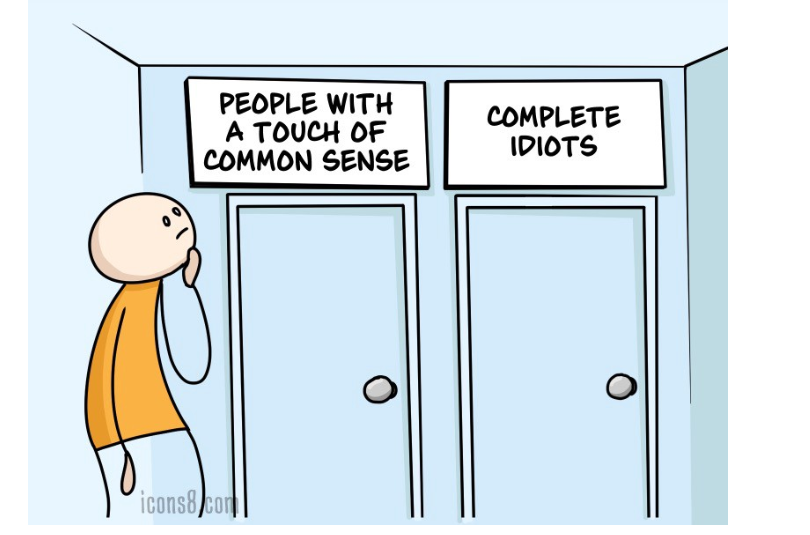5 misconceptions that need to “be removed” when testing products
- Tram Ho
Currently, I am doing more than 50 studies on user experience at Icon8. During the study, I realized one thing, there are many theories, academics and articles that mislead readers with false knowledge. And even completely against the “thinking of mankind.”
Here I will point out some facts about improper myths about UX design usability, from which you will see a clear comparison between those mistakes and the knowledge that I have distilled it.
Myth # 1 Don’t listen to users
The person who made the statement was Jakob Nielsen, one of the pioneers of usability research. One of the first “rules” of usability was born here. Of course, getting feedback from direct interactions on the product is paramount, but this does not mean that professionals do not need to listen to anything from their users. The question is, When should I hear? Of course, this question was answered in the same article: You should only get information from users when they have actually experienced the design and have real feelings about it.
In that respect, what do you get from dry data, or in other words, from people you don’t interact with much? I myself have learned quite a lot during the research process request icon service:
-Most people will be able to complete all tasks.
– People often like new and modern designs.
Everything looks fine but except for one thing. After completing the tasks, they will ask: “Eh? So what does this interface mean? “. After I’ve heard so many similar questions. I have a conclusion like this.
Listen to users when they complete tasks. Don’t just rely on dry numbers. And if there is no interaction with the user, they will do the product test but don’t really know anything about it.
Myth # 2 One hundred reasons better than 5 reasons.
Those who say that 100 people are better than 5 people will never get stuck in traffic. You can use that example to compare whether a large-scale automated test is better than a one-on-one interview. While automated testing is a good tool, it is not the “ultimate weapon” for you. Why?
First of all, it requires good qualifications, knowledge and skills to be able to work on a terrible data circuit in the most accurate way.
Suppose I have an egg hatchery, and I say 10% of my eggs are broken, so what do you do?
a) increase the number of chickens to compensate for losses
b) focus on safety to reduce recent losses
c) chasing the careless guy
Big data can help us be confident but not help us avoid unexpected situations. The private interview helped me have more deep and objective views on things I thought I knew long ago.
Of course, I do not encourage you to interview each chicken to solve the problems of the farm (3-4 children are more than enough). I just want to say that automatic testing sometimes produces very different results than direct user interviews.
Moreover, the interview will give you a lot of special information and differences between users and product makers.
In summary, both automated testing and face-to-face interviews play many separate roles, they can effectively support each other.

Myth # 3 Don’t change the Script
If you start preparing the script 2 minutes before the interview, you are a bit “brave”. If you change the script while making a film, people will call you a vision. But if the script changes before the interview is too close, it is almost like suicide.
Why are people who make UX afraid of changing scripts in the process? Because they are afraid of ending it will not be objective. You need 5 people to do the same thing to make some necessary conclusions for the interface.
I agree with getting the most objective feedback possible, however I disagree with turning your script into a rigid thing. In many of my studies, I even discovered that a lot of people don’t care about the push button even though it appears very big from the beginning. If I didn’t ask “did you see that button before doing the task?”, I’m not sure I understood that strange behavior. So you need a little flexibility in your script questions.
Some people still argue that having a rigid script will help participants feel more comfortable. Participants will clearly feel that the interviewer knows what they are doing. What to say now? Indeed, the information we exploit is more important than whether people feel comfortable or not? It is also one of the things that people do professional UX should care about.
In summary: having scripts is also very convenient, but don’t hesitate to add other things if you feel really necessary. Just make sure that the changes do not affect the overall process of the study.

Myth # 4 See testers like industrial chicken
The test room environment is simply a table, chair and a test person and the computer, they come and do the tasks to do. There will also be a camera and sensor attached to monitor facial behavior as well as body language. The main purpose is to create an isolated environment to avoid unnecessary external influences.
Some other authors even suggest that when chatting via Skype, it is necessary to limit contact with users. Although I also agree on this point, I do not agree with treating people like industrial chickens like that.
No matter how quiet and aloof you are, testers still know that they are being followed. Even if you do not need to do anything, the role of the supervisor of the test will always be present, besides it has some “side effects” like this:
-The participant will treat you as an authority and find ways to please you with answers that are sometimes not true.
-They will feel embarrassed to admit their mistake during interaction with the UI.
-They will use the product differently than the way they will use everyday.
I just want to say! Be more friendly. Personally, I always want to interact with testers, some jokes and common social questions that will help them both feel more comfortable so they will also want to share more. You also get more important information about the product. Things that aren’t always easy to say when you’re not comfortable.
In short: Do not say too much, instead create the most comfortable and natural atmosphere possible for both parties to work easily.

Myth # 5 Common sense is not enough
Usability is one of the topics that anyone can comment on. From the boss’s bosses to the unemployed grandfather lying at home. This does not mean that there are no real experts in this area. There are a few “expertise” that experts in this field may have to take:
-Psychology
– Psychological behavior
– Basic design skills
-Communication skills
-Manage data
-Many practical experiences
To hire such a person is very expensive, so the public usually assign this task to 1 “someone”, if the person has common sense, the effect will not come.
If you don’t get this experience in your hands but want to try your product, why don’t you try doing it yourself?
The basic design principle is that 80% of users will use 20% of the product, and that part is also the core part of the product. Determine the core of the product and then create interoperable tasks for it. Then look at how people interact, don’t remind them well, let them experience the product themselves. From there you will also see real problems rather than simply taking someone’s subjective opinions.
Summary: Experts will always be the first choice for UX development. However, if it is common sense, that means you understand the situation, everything will be fine.

Conclude
The rumors about the feasibility I just pointed out in this article have partly removed human factor and tried to make it as “inhuman” as possible. In a certain way this is not wrong, but in fact everything will be very different when people really experience it. Imagine when you were bathing, someone strangely picked up the paper to ask you, did the shower take pleasure? How will you feel?
However, if you can make the test feel no longer in an experiment, the opposite will happen. People will always react in a way that they will not react in everyday life. The best way is to experiment in natural conditions, but find all possible ways to observe all angles. It is not known when the product availability testing industry will begin to do what I mentioned.
So what do we need to keep in mind? Create a friendly environment, the environment in which testers can feel confident. Don’t try to eliminate human factors. At least when we talk outside the lab, but who knows? What about the ways I speak can also show miraculous effect in the lab?
ITZone via UX planet
Source : UX planet

